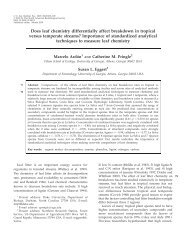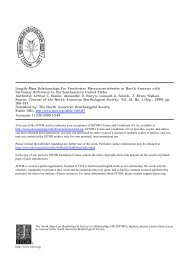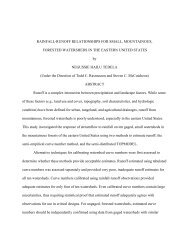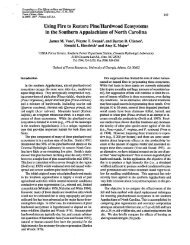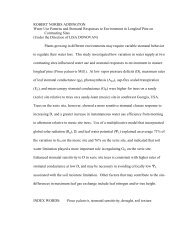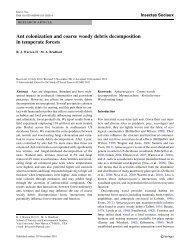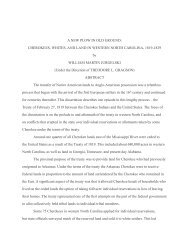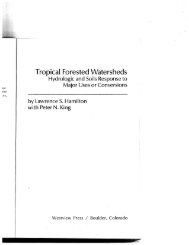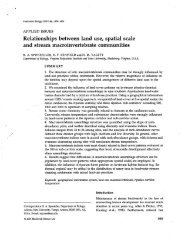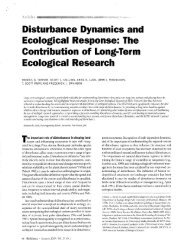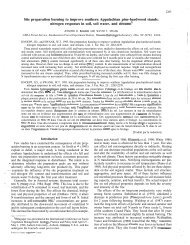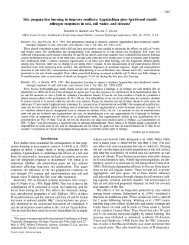biology join - Coweeta LTER - University of Georgia
biology join - Coweeta LTER - University of Georgia
biology join - Coweeta LTER - University of Georgia
You also want an ePaper? Increase the reach of your titles
YUMPU automatically turns print PDFs into web optimized ePapers that Google loves.
increased irrigation using groundwater or water imported<br />
from other basins may explain increasing streamflow during<br />
dry seasons at a desert site in New Mexico (JRN) and a<br />
savanna site in southern California (SBC), which have some<br />
agriculture and residential development (figure 7c, 7d).<br />
Increasing winter streamflow trends at a temperate forest<br />
site (PIE) may reflect urban expansion (Claessens et al.<br />
2006). Therefore, human effects on streamflow may mimic,<br />
exacerbate, counteract, or mask climate effects on streamflow,<br />
making it challenging to determine the vulnerability<br />
<strong>of</strong> human communities (sensu Polsky et al. 2007) to variations<br />
in water supply.<br />
Headwater basins in this study drain into major river<br />
systems that supply water to major agricultural areas and<br />
medium and large cities. Climate change is expected to<br />
increase the variability <strong>of</strong> future streamflow and to stress<br />
municipal water supplies (Milly et al. 2008, Covich 2010,<br />
McDonald et al. 2011, USDOI 2011). Long-term studies<br />
<strong>of</strong> headwater basins can help distinguish biophysical from<br />
social causes <strong>of</strong> variability in water supply and, hence,<br />
the relationships between ecological and social resilience<br />
(Adger 2000). Water scarcity may be perceived even in<br />
areas with abundant rainfall, where politics rather than<br />
true scarcity may govern water restrictions (Hill and Polsky<br />
2006). Meanwhile, residents, pr<strong>of</strong>essional policymakers,<br />
and academics in Phoenix (CAP) implicated population<br />
growth, climate change, and drought as the most important<br />
causes <strong>of</strong> water scarcity, rather than their own wateruse<br />
habits (Larson et al. 2009). Adding to this research,<br />
in this study, we suggest that rather complex interactions<br />
among historical social factors, ecosystem processes, and climate<br />
influence the long-term water supply from headwater<br />
basins.<br />
The role <strong>of</strong> information management<br />
Long-term ecological data are critical to answering societal<br />
questions <strong>of</strong> national concern and significance. Long-term<br />
data are the only way to distinguish trends from short-term<br />
variability in key environmental indicators, such as climate<br />
and streamflow. However, many long-term data remain<br />
inaccessible or difficult to access. Many valuable data sets are<br />
stored in inconvenient file formats with limited metadata.<br />
Variations in methods, variables, units, measurement scales,<br />
and quality-control annotation complicate data integration<br />
and prevent automated approaches to data synthesis.<br />
Until the 1990s, the difficulty <strong>of</strong> identifying, accessing,<br />
and integrating climate and hydrologic data from<br />
the <strong>LTER</strong> Network, EFRs, and related networks precluded<br />
cross-site studies. ClimDB/HydroDB (http://climhy.lternet.<br />
edu), a collaborative effort between <strong>LTER</strong> Network and<br />
USFS information managers, was initiated in 1997 to<br />
overcome these limitations. ClimDB/HydroDB is a Web<br />
harvester and data warehouse that provides uniform access<br />
and visualization <strong>of</strong> daily streamflow and meteorological<br />
data through a single portal. Participating sites manage<br />
original data within their local information systems but<br />
Articles<br />
periodically contribute data to the warehouse. Although<br />
the ClimDB/HydroDB approach is not a complete solution<br />
to data-access and -integration issues, it has served as an<br />
effective bridge technology between older, more rigid data-<br />
distribution models and modern service-oriented architectures<br />
(Henshaw et al. 2006).<br />
The <strong>LTER</strong> Network has made great strides in collecting,<br />
archiving, and integrating long-term data sets online,<br />
enabling synthesis activities such as this one, and providing<br />
an example for other environmental observatories.<br />
Information managers at <strong>LTER</strong> Network sites have led the<br />
development <strong>of</strong> metadata standards, data dictionaries, and<br />
s<strong>of</strong>tware for data integration. The <strong>LTER</strong> Network datamanagement<br />
system serves as a model for emerging national<br />
observatories and existing programs.<br />
Conclusions<br />
This study provides an example <strong>of</strong> the special kinds <strong>of</strong> science<br />
that are possible from networks <strong>of</strong> long-term study<br />
sites. Climate and streamflow records are sufficiently long<br />
that averages, variability, and trends can be meaningfully<br />
analyzed. The climate and streamflow properties are<br />
simple and comparable because they are consistently measured<br />
across sites. Climate and streamflow data are broadly<br />
relevant to ecosystem processes and ecosystem services.<br />
Above all, multisite synthesis is fostered by and contributes<br />
to an open, inclusive culture <strong>of</strong> science collaboration.<br />
This study showed that actual evapotranspiration was<br />
predicted by PET at only 7 <strong>of</strong> 30 sites with 10-year-long<br />
records (the Budyko curve). Taken individually, these departures<br />
might simply reflect the inability <strong>of</strong> a climate station<br />
to represent the conditions <strong>of</strong> a whole basin or the fact<br />
that streamflow depends on groundwater and other forms<br />
<strong>of</strong> storage, as well as precipitation and temperature. But<br />
taken collectively, the departures <strong>of</strong> these sites from the<br />
Budyko prediction suggest the intriguing hypothesis that<br />
water-scarce ecosystems evapotranspire less and waterabundant<br />
ecosystems evapotranspire more than would<br />
be predicted from their climates. Moreover, streamflow<br />
at many <strong>of</strong> these sites was significantly related to one or<br />
more climate index (ENSO, NAO, or PDO), which is not<br />
surprising, but the slightly more frequent significant correlations<br />
<strong>of</strong> streamflow with climate indices in winter than<br />
in summer imply that ecosystem processes mediate climate–<br />
streamflow coupling. Finally, 17 <strong>of</strong> 19 sites had significant<br />
increases in their minimum or maximum daily temperatures<br />
or both, but streamflow trends were directly related<br />
to climate trends at only 7 <strong>of</strong> the sites, all <strong>of</strong> which have<br />
permanent or seasonal ice and snow. In contrast, at other<br />
sites, and during certain seasons at these seven sites, streamflow<br />
trends were contrary to those expected from climate<br />
drivers.<br />
A key finding from this study is that the past and present<br />
human uses <strong>of</strong> ecosystems and human water-use practices<br />
can mimic, exacerbate, counteract, or mask the effects <strong>of</strong><br />
climate change on streamflow. Social factors, including<br />
www.biosciencemag.org April 2012 / Vol. 62 No. 4 • BioScience 401



